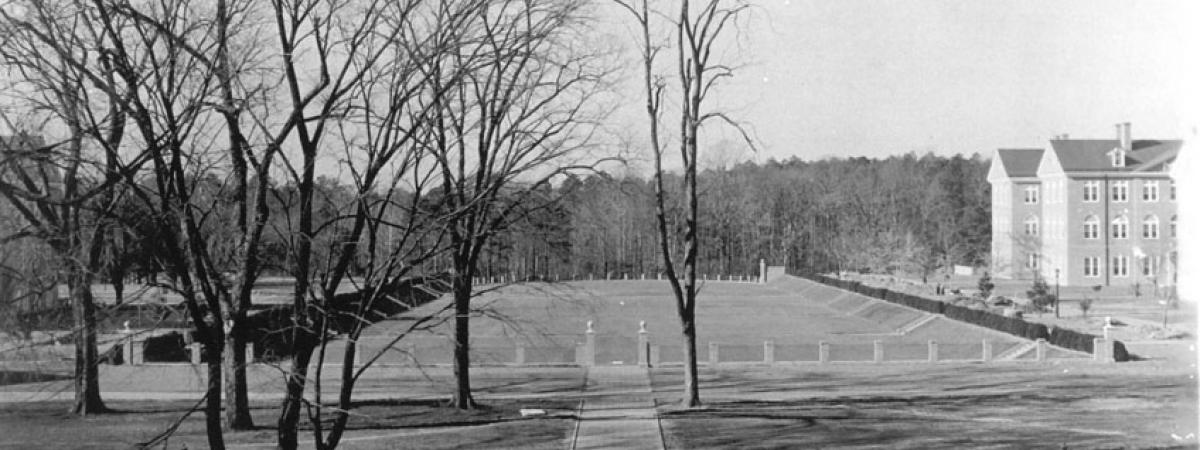
Landmarks
Landmarks
Campus Tour of Woody Species
The Campus Tour of Woody Species is available online from the Department of Biology. "Among the scenic locations on campus can be found more than 300 species and varieties of woody plants, a living archive that also supports research by faculty and students at the College. By vote of the Board of…College Bell
The College Bell resides in the cupola of the Wren Building and is typically rung by graduating seniors on the last day of classes. The current bell is William & Mary's sixth.College Cemetery
The College Cemetery is located on Blair Road, east of Blow Gymnasium (now Blow Memorial Hall). The cemetery was established at the faculty meeting of January 18, 1859, for the use of professors and their families, and students.College Corner
College Corner is one of the names commonly used to refer to the intersection of Richmond and Jamestown Roads with Boundary and Duke of Gloucester Streets adjacent to William & Mary. Around the 1950s-1960s it was also known as Jockey Corner or Jockey's Corner. This name came about because it…College Woods
The College Woods, located on the northwestern side of the William & Mary campus, originally totaled around 1200 acres when it was developed by the College and the Civilian Conservation Corps (C.C.C) between 1933 and 1934. Dubbed Matoaka Park, the College Woods was intended for the enjoyment…College Yard
College Yard 1869 The College Yard is the area surrounded by the Wren Building, the Brafferton, and the President's House.Crim Dell
The Crim Dell is a small pond located on the section of road connecting Landrum Drive and Blair Road, between old and new campus.Hearth: Memorial to the Enslaved
William & Mary is in the midst of constructing a memorial to the people who were enslaved by the university. Titled “Hearth: Memorial to the Enslaved,” the brick structure will resemble a fireplace and will feature the names of people who are known to have been enslaved by the university.Jamestown Road Tunnel
The Jamestown Road Tunnel was a tunnel that ran underneath Jamestown Road in front of Willis Hall (formerly Taliaferro Hall), which opened in September 1960. It was also known as Alvin's Alley, likely a reference to College president Alvin Duke Chandler.Lake Matoaka
Prior to acquisition of the original charter for William & Mary in 1693, Lake Matoaka was an open watercourse of streams and wetlands known as Archer's Hope Swamp.Martha Barksdale Athletic Field
Barksdale Field is located adjacent to Phi Beta Kappa Memorial Hall and Rogers Hall (ISC 2), at the corner of Jamestown Road and Landrum Drive. Named for Martha Barksdale, long-time Physical Education Professor and member of the first class of women at the College, Barksdale Field was dedicated on…Memorial Garden
The William & Mary Memorial Garden "located in College Woods - just off the main path between Miller Hall and the Lake Matoaka Amphitheater, will provide a dignified, reflective place to memorialize deceased alumni, faculty, staff, their families and friends of the College."Sculptures on campus
There are many sculptures and statues on the grounds of William & Mary. These include multiple statues by David Turner, the James Monroe statue, the statue of John Marshall and George Wythe, King and Queen Gate statues, Lord Botetourt statue, and many more.Sunken Garden
The Sunken Garden is located to the rear of the Wren Building, running southwest, on the campus of William & Mary.Underground Steam Tunnels
A notorious pastime of William & Mary students is exploring the underground steam tunnels under Old Campus and Historic Campus. The college administration has explicitly prohibited entry to these tunnels in the Student Handbook: "For reasons of safety and security...mechanical equipment areas…Wildflower Refuge
Located near the Crim Dell at William & Mary, the Wildflower Refuge shelters four Trillium species, a variety of ferns, and a number of common wildflowers.
